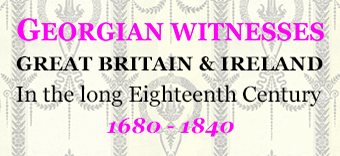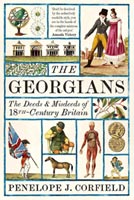Georgian Witnesses
8 / SIGNIFICANT GEORGIAN CONTRIBUTIONS BOTH TO RELIGIOUS WORSHIP AND TO SCEPTICISM
CONTRIBUTIONS TO WORSHIP
THREE GEORGIAN CAROLS
The Georgian era saw the composition of many famous hymns, thereby encouraging congregations to participate directly in services and helping to fix the words into people’s memory-banks. Christmas carols had a similar impact, including the following three newly-minted in this period:
8.1 While Shepherds Watched their Flocks by Night (1703), based on the Gospel of Luke 2:8-14, was written by Nathan Tate (1652 – 1715), the Irish-born hymnodist and dramatist who became Poet Laureate (1692). It is sung to a variety of tunes, including, in the UK, ‘Winchester Old’ by George Kirbye, and, in the USA, ‘Christmas’ by Handel, arranged by Lowell Mason.
Nathan Tate is buried at St George the Martyr Church, Borough High Street, London SE 1 1JA, having died in The Southwark Mint (a legal sanctuary, before 1722), where he had withdrawn to escape his creditors
8.2 Joy to the World (1719), drawing upon Psalm 96:11-12, Psalm 98, and Genesis 3:17 – 18, was written by Isaac Watts (1674 – 1748), the famed Congregationalist hymnodist whose output was quickly accepted for use in Anglican services. Different selections of the verses appear in different hymnals; and, initially, the carol was sung to a variety of tunes, including one with similarities to the 1848 arrangement by Lowell Mason, which then rapidly became the standard.
Isaac Watts is buried in Bunhill Fields Burial Ground, London EC 1Y 2BG.
8.3 Hark the Herald Angels Sing! (1739) was written by the great Wesleyan hymnodist, Charles Wesley (1707 – 88), brother of the evangelist John Wesley. The initial choice of accompanying music was slow and solemn, as requested by Charles Wesley; but the carol acquired its current jaunty music in the nineteenth century, when an English musician adapted a cantata, written by Felix Mendelssohn in 1840, to fit the words.
Charles Wesley is buried, at his own request, in the Anglican burial ground of St Marylebone Parish Church, 7 Marylebone Rd, London NW1 5LT, close to where he had lived in the last years of his life.
THREE NOTABLE PREACHERS
8.4 Bishop Joseph Butler (1692 – 1752), Anglican theologian and moralist, was an influential preacher, known for his probing intelligence and rigorous arguments. His Fifteen Sermons at the Rolls Chapel (1729), which contributed to studies of psychology as well as theology, encapsulated his approach to moral philosophy, celebrating the ‘still small voice’ of conscience.
Bishop Butler is buried in Bristol Cathedral, College Green, Bristol BS1 5TJ, where he was Bishop between 1738 and 1750.
8.5 George Whitefield (1714 – 70) was a notably hypnotic and powerful preacher whose work provided the basis for the foundation of the separatist church of Calvinist Methodists. His forte was open-air preaching, where his magnetic presence, his loud bell-like tones, and his rhetorical style generated strong emotions among his listeners in Britain and America.
George Whitefield is buried in the crypt of the Old Presbyterian Church, Newburyport, Massachusetts, USA.
8.6 William Williams Pantycelyn (1717 – 91) was foremost among many gifted Welsh Methodist evangelists, noted for his poetry, hymn-writing, and literary style. He was an indefatigable preacher and organiser of many local Methodist ‘fellowship meetings’ across Wales, encouraging participation through hymn-singing.
William Williams Pantycelyn is buried in the churchyard of Llanfair-ar-y-bryn Church, 1 Llanfair Rd, Llandovery SA 20 0HY Carmarthenshire, Wales, close to where he was born.
THREE FOUNDERS OF LONG-SURVIVING MINORITY SECTS
8.7 The Rev. John Glas (1695 – 1773) was a clergyman in the Presbyterian Church of Scotland, who in 1725 started the separate Glasite movement, with supporters drawn from his own and neighbouring parishes. They were committed to a simple and literal form of Christianity, following the New Testament, and holding their goods in common. The movement expanded under the tutelage of Glas’s son-in-law, Robert Sandeman (1718 – 71), by whose name their churches were later known, with new groups in Scotland, England and the USA. The movement survived until the later twentieth century, the last known Sandemanian meeting-house in the UK closing in 1984.
John Glas is buried in The Howff burial ground, Dundee, where the original sandstone headstone became eroded and was replaced (c.1880) in red granite. Robert Sandeman is buried in Wooster Street Cemetery, Danbury, Fairfield County, Connecticut, USA.
8.8 Emanuel Swedenborg (1688 – 1772), Swedish scientist and mystic, propounded a new theology, especially in his Heaven and Hell (1758), exploring spiritual meanings from material experiences and rejecting conventional Trinitarian theology. He spent a number of his adult years in London, where he died, and where in 1778 the New (Swedenborgian) Church was founded based upon his teachings. It continues today, as do a number of other Swedenborgian churches and associations in the UK and USA.
Emanuel Swedenborg was initially buried in the Swedish Church, Princes Square, Shadwell, London E1 but in 1912/13 his body was exhumed and reinterred in Uppsala Cathedral, Uppsala, Sweden. A small memorial park in East London was created in his honour in 1997: Swedenborg Gardens, 20 The Highway, London E1W 2BE.
8.9 Joanna Southcott (1750 – 1814) was a West Country farmer’s daughter who, after an uneventful youth, declared herself in her 40s to be a prophetess; produced extensive prophetic writings; and went to London, where she gained a considerable following, to whom she issued signed ‘seals’ as individual guarantees of salvation. Then, at the age of 64, she announced, to much excitement and some derision, that she was pregnant with the new Messiah – a claim that was endorsed by some respectable doctors. After her death, childless, most of her following faded; but a small semi-secret Southcottian movement survived, at times spawning further prophets who claimed to follow her inspiration, such as John ‘Zion’ Ward (1781 – 1837).
One offshoot of her church, known as the Panacea Society (founded 1920), survived in Bedford until into the twenty-first century; and today the Panacea Charitable Trust in Bedford funds a Souhcottian archive and museum, as well as community projects.
Joanna Southcott is buried in St John’s Wood Burial Ground, St John’s Wood, London NW8 7PF.
CONTRIBUTIONS TO SCEPTICISM
THREE INTELLECTUAL BLOWS TO LITERAL BELIEF IN THE BIBLE
8.10 David Hume (1711 – 76), pre-eminent Scottish philosopher and archsceptic, applied his scything intellect to a critique of miracles. His Enquiry Concerning Human Understanding (1748) devoted Section X to a consideration ‘Of Miracles’, subjecting miraculous claims to the tests of science and logic. Hume was not without his critics, then and later, but his rationalist and sceptical approach had a big impact, especially in the long term. David Hume was not an outright atheist but he was a sceptic, who died stoically, refusing Christian sacraments on his deathbed, despite pleas from his friends.
David Hume is buried in a cylindrical mausoleum, designed by Robert Adam, located in the Old Calton (non-denominational) Cemetery, Waterloo Place, Edinburgh EH 1 3BQ.
8.11 Edward Gibbon (1737 – 94), historian of ancient Rome, did not set out explicitly to write an anti-Christian polemic. Yet chapters 15 and 16 of his major work, The History of the Decline and Fall of the Roman Empire (1776), highlighted the absence of reliable contemporary evidence for the birth and death of Jesus Christ, as well as offered a severe critique of the role of early Christianity in the decline of the Roman Empire. The furious backlash which followed showed that Gibbon had touched many live nerves, prompting him to produce his Vindication of Some Passages in the 15th and 16th Chapters in The History of the Decline and Fall of Rome (1779). Gibbon’s impact as a historian outlived this specific controversy, while it also contributed to less- literalistic readings of The Bible.
Edward Gibbon is buried in the Sheffield family mausoleum, in the Church of St Andrew & St Mary the Virgin, Fletching, Uckfield, East Sussex TN22 3SY.
8.12 James Hutton (1726 – 97), Scottish geologist, naturalist and agriculturalist, pioneered the subject of geology, demonstrating the great age of the planet and the prolonged mixture of upheavals and gradual changes which combined to produce the Earth’s rock formations. He located those developments in what is now termed Deep Time, and Hutton stated, famously, that on the basis of geological evidence: ‘There is no vestige of a beginning, no prospect of an end‘. Again, not all agreed with Hutton, either then or later. Yet his work also had a profound long-term impact, providing a framework for (later) Darwinian biology and discouraging a strict Biblical literalism.
James Hutton is buried in the Greyfriars Kirkyard, 26A Candlemaker Row, Edinburgh Old Town EH 1.
THREE WHO EXPRESSED PUBLICLY THEIR DISBELIEF IN CHRISTIANITY
8.13 Thomas Aikenhead (1676 – 97), the last person in the UK to be tried and executed for blasphemy, was a student at the University of Edinburgh, who was heard ridiculing the Scriptures, rejecting the Trinity, and declaring a preference for Muhammad over Christ. He was not the first, or the last, to express disrespect for Christianity. But he was supremely unlucky. The death penalty for ‘blasphemy’ was very rarely applied before 1697 (having been dropped in England/Wales in 1676) and was de facto allowed to lapse after 1697, before being legally abolished by Parliament in 1825. From prison, the 20-year-old Aikenhead expressed deep contrition; and there were many appeals for clemency on his behalf. However, the Scottish authorities were obdurate, hoping that this death would prove a deterrent to rising tides of sin and irreligion.
Thomas Aikenhead was hung after walking, under guard, from the Old Tolbooth in central Edinburgh to gallows on a mound at Shrubhill on the Edinburgh/Leith Walk (EH 7 4FG). The fate of Aikenhead’s body is not recorded but it was probably buried hastily in unhallowed ground nearby. There is no memorial to this youthful martyr for free speech; and the gallows were dismantled and the gallows mound levelled in the 1770s, leaving no physical evidence of the site’s historic role.
8.14 John Hollis (1742-1824) wrote his frank Apology for Disbelief in Revealed
Religion in 1799, following an outcry after his earlier publication, Sober and Serious Reasons for Scepticism (1796). Hollis, who came from a wealthy English Dissenting background, evidently had no fear of legal penalties and was prepared to ride out the intellectual furore caused by his views.
John Hollis died in High Wycombe, Buckinghamshire, and is buried in the nave of its parish church All Saints (Church Square, High Wycombe, Bucks. HP11 2BN), where his memorial plaque stresses his benevolence to the poor and makes no reference to his earlier freethinking publications.
8.15 Percy Bysshe Shelley (1792 – 1822), ‘Romantic’ poet. radical, and publicly confessed freethinker, wrote The Necessity of Atheism (1811) while still a student at Oxford University. It caused sufficient outcry for him to be sent down from University College; but there was no move to prosecute him for blasphemy. This episode was far from the only controversy in the short, turbulent life of Shelley but it is doubly instructive. Firstly, it shows how the public responses had changed over the preceding hundred years, in contrast to the extreme severity shown to Aikenhead; and secondly, Shelley’s prose equally indicates the advent of a cool rationalism in lieu of religious fervour, when he observed drily that: ‘God is an hypothesis, and, as such, stands in need of proof’.
P.B. Shelley is buried in the Protestant Cemetery at Rome, to which location his ashes were taken after he had drowned in a Mediterranean storm off Lerici in 1822 and, ten days later, his partially decomposed body had been ceremonially burned on the beach at Viareggio by his friends. In 1893 a marble monument, showing the dead Shelley as a reclining nude, was installed at University College, Oxford (High St, OX1 4BH), marking, if not a retrospective apology, at least the College’s later glad acceptance of its famous alumnus.
THREE ATTEMPTS AT DEVISING A SYSTEM OF NON-RELIGIOUS FAITH AND ETHICS
8.16 John Toland (1670 – 1722), the Irish-born freethinker, threw down the intellectual gauntlet with his Christianity Not Mysterious (1696), arguing that the core propositions within The Bible did not depend upon revelation but could be deduced by reason, based upon natural principles. Members of the Irish Parliament wanted to burn him at the stake as a heretic; but, in his absence in England, burned copies of the book instead. Thereafter, Toland’s views on religion became more radical, arriving at a form of pantheism with multiple gods. His Pantheisticon, written in Latin and printed privately in 1720, sought to develop a non-Christian liturgy, based upon writings of pre-Christian philosophers; but this work (published in English in 1751) had little immediate impact. John Toland died, as he had lived, in poverty, surrounded by his books.
John Toland is buried in an unmarked grave in the churchyard by the Thames of the Anglican church St Mary’s, Putney High Street, Putney, London SW15 1SN , near to his modest home in his later years
8.17 Robert Owen (1771 – 1858), the tireless Welsh textile manufacturer, reformer, and philanthropist, declared in 1817 that: ‘All religions are false’. However, late in life, he was converted to a humanist spiritualism, believing that later generations could channel the spirits of ‘good and superior’ men and women from earlier generations, in order ‘to prepare the world for universal peace, and to infuse into all the spirit of charity, forbearance and love’. Today there are Spiritualist Churches which follow the Seven Principles, defined in 1871 by the medium Emma Britten, invoking the Owenite ideals.
In his old age, Robert Owen returned to his native Newtown, a small market town in Montgomeryshire (now in Powys), where he died in 1858 and – despite some protests because of his expressed atheism – was buried in St Mary’s Old Churchyard, (The Cross, Broad Street, Newtown, Powys SY16 2BB Wales). Forty years later, the radical journalist and co-operator, G.J. Holyoake (1817 – 1906), a younger disciple of Owen, visited the grave, which was then in a state of decay, and raised funds from the Cooperative Movement to commission an impressive Art Deco memorial tomb (dedicated 1902).
8.18 Frances ‘Fanny’ Wright (1795 – 1852), the Scottish-born feminist, radical reformer, and freethinker, toured England, and later the USA, where she became a citizen in 1825, lecturing on her radical principles and her opposition to organised religion. Wright tried many different means to inculcate her ideas, lecturing publicly (the first woman to do so in the USA), writing books, editing journals, and in 1826 founding an experimental community at Nashoba (Tennessee), which sought to educate freed slaves for independent living. However, this project failed within five years, facing the difficulties of organisation and funding that bedevilled many experiments in establishing alternative societies. Wright’s strong belief in sexual freedom, including between diverse ethnic groups, combined with her radical politics, and her advocacy of a simplified dress code for women, brought her much opposition and barracking. Her views were propagated for a while by grass-roots Fanny Wright Societies in the USA; but these did not coalesce into a long-term movement, as – unlike organised churches – radical reform groups often lacked regular structures and funding.
Frances Wright died in Cincinnati, Ohio, and is buried in its Spring Grove Cemetery, Spring Grove, Ohio OH 45232, United States. Her name was later included in the Reformers Memorial at Kensal Green Cemetery, Harrow Rd, London W10 4RA – the Monument being created in 1885 by book- binder and radical activist, Joseph William Corfield (c.1810 – 88).




